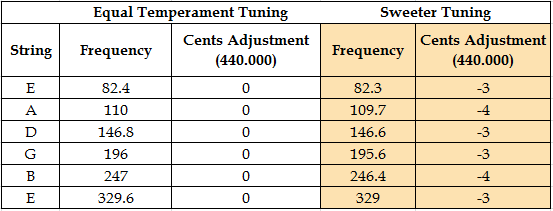The Secret to Tuning Your Acoustic Guitar Perfectly
The secret to tuning your guitar perfectly is simple: Adjust your tuning 'temperament'.
But what is a temperament?
Historically, musical notes have not always been the same distance apart. The ancient Greeks based their tuning system on mathematical ratios that produced perfect 5th and 4th. This "Pythagorean tuning" produced very consonant 5ths and octaves, but sacrificed consonance in 3rds and other intervals.
In the Middle Ages, folks tried to fix the problem with the 3rd interval and began using other tuning systems like meantone termperament and quarter-comma meantone.
And later, in the late 17th century, the well temperament developed by German organist Andreas Werckmeister began to approach the system that we use today. This tuning fudged some of the interval distances, allowing a piano to be playable in all keys. Some inconsistencies remained, however, so that different keys had slightly different 'personalities'. Bach is thought to have written his famous Well-Tempered Clavier, including pieces for all 24 Major and Minor keys, to make use of the unique characteristics of each key in this system.
Singers and wind instruments have also used a system called just intonation. In this system, the notes in a scale all sit at a relative distance from the home note. This system makes for very pleasing and consonant harmonies (especially of the Major 3rd), but only if you stay in the original key! In a sense, the exact note pitches are 'optimized' for the key that you start from.
Equal Temperament
Then in the 20th Century, Western music began to use equal temperament. In an equal temperament system, all notes are a fixed multiple of basic value (440 Hz). In equal temperament, every semitone is precisely the same distance apart. This means two things:
- When changing keys, the notes of the scale relate to each other precisely as they did in the previous key, and
- Some intervals will never sound quite as pleasing as they would have in one of the other temperaments.
The advantages of "equal temperament" are huge for Western music: you can transpose music, change keys within a piece, and use fixed pitch instruments (keyboards, MIDI electronic keyboards) across multiple keys easily.
How do we take advantage of this for guitar?
Electronic guitar tuners (and most apps) use equal temperament. That's why you see the "440Hz" on the face of the tuner. Using this temperament creates a slight dissonance in the standard tuning of a guitar, particularly in the G and B strings because they're a Major 3rd apart.
Additionally, when the notes of an acoustic guitar are fretted, the fretted notes are not completely accurate. Typically, they're a little sharp. This results from the pinching of the strings.
The way to compensate for these problems is to adjust our tuning slightly. We can essentially create a tuning temperament specifically for the acoustic guitar. The way to fix this is to tune the guitar slightly flat, and just a hair flatter on the A and B strings. Here's a chart:

Notes on the data:- 1 Cent adjustment covers about .2 frequencies, so there's some latitude there - Adjusting for Cents below equal temperament is a more practical method than adjusting for Freq.
The Bottom Line:
Next time you tune your acoustic guitar, try tuning a few cents below the "in tune" setting on your tuner (using the chart above). You'll have a 'sweeter' and more resonant sounding guitar.
As it happens, there is a tuner app that will do this for you - VITALtuner. This has become my 'go to' tuner, and I discovered this improved temperament through their app. While, of course, I tried to do my "due diligence" for this particular post, credit goes to them for the details of the 'perfect temperament' for acoustic guitar.
 VITALtuner™
VITALtuner™
by Otreus Inc. | Website[minimal_table]
Platform: iOS
Reviews: 9 (5 stars)
Overall Reviews: 13 (5 stars)
Price: $4.99

FAQ
Q: What about the Buzz Feiten system?
A: You can use VITALtuner with guitar mods like the Buzz Feiten intonation system. Those offsets are patented so they can't be included in VITALtuner, BUT you can add custom offsets into VITALtuner. So all you need to do is Google search for the offset numbers and manually enter them into VITALtuner and you're good to go with a Buzz Feiten modified guitar.

